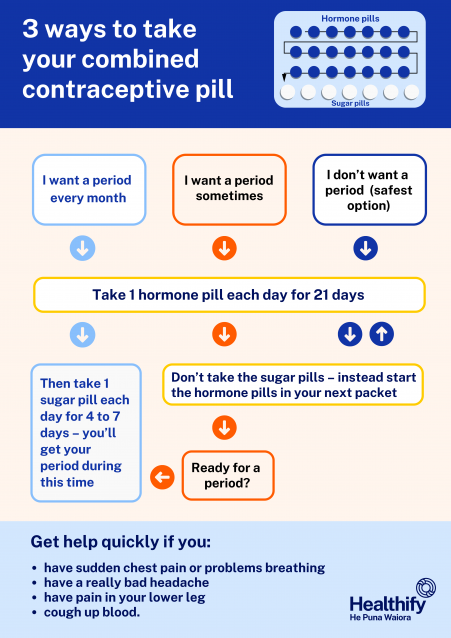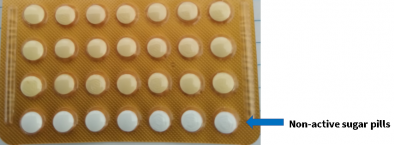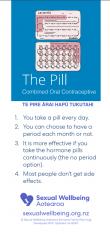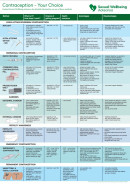Combined oral contraceptive pill
Commonly known as ‘the pill’
Key points about combined oral contraceptive pill
- The combined oral contraceptive pill (also called 'the pill') is used to prevent pregnancy.
- Find out how to take it safely and possible side effects.

The combined pill, also called ‘the pill’, contains the hormones oestrogen and progestogen. It's a pill or tablet that you take every day to stop getting pregnant. It works by stopping ovulation (which is when an egg is released from your ovary). The combined pill is also used to treat heavy menstrual (period) bleeding (also called menorrhagia). It makes the lining of your uterus thinner which makes your periods lighter.
The combined pill is one of the more reliable forms of contraception
- If used correctly, the pill is 99% effective in preventing pregnancy.
- However, most of us are not perfect, and sometimes we forget to take it every day, so in real life it's usually only 92% effective. This means that about 8 out of 100 people who use the pill each year will get pregnant.
- To make sure the pill works best, you need to take it every day, whether you have sex on that day or not. Learn more below about how to take the combined pill.
- It's important to know what do you if you miss a dose. See below what should I do if I miss my dose?.
- It's also important to remember that if you're sick (vomit) soon after taking your pill, or have diarrhoea (runny poo), the pill may not be absorbed and may not work. See below – what if I have diarrhoea (runny poo) and vomiting (being sick)?
Note: The combined pill isn't suitable for everyone. There's information below about who cannot take the combined pill.
There are 2 types of oral contraception available in Aotearoa New Zealand. The combined pill has the hormones oestrogen and progestogen. This page covers information about the combined pill. There is also a progestogen-only pill (or mini pill), which contains only progestogen. Read more about the progestogen-only pill.
Examples of the combined pill
- There are a variety of brands and strengths of the pill available in Aotearoa New Zealand. They contain different combinations of oestrogen and progestogen.
- Your doctor will help you decide the best combination for you.
- If you experience side effects, you may need to try a few different types before you find one that suits you.
Some brands of the pill can be purchased from your pharmacy without a prescription if you meet the criteria. See below: Can the combined pill be purchased without a prescription?
| Examples of the combined pill | |||
|
|
||
| Pros | Cons |
|---|---|
|
✔ You can choose to have a period each month or not. |
✘ It needs to be taken each day at the same time of the day, whether you have sex on that day or not. ✘ It's not suitable for everyone. |
You will need to take 1 pill each day, at about the same time each day.
- Usually a pill packet has 21 ‘active’ hormone pills and 7 non-hormone pills.
- The non-hormone pills are also called sugar pills. See below – what are sugar pills?
When taking the pill, you don't need to have a period every month. The following 3 options give you some choice.
The most effective option to prevent pregnancy is if you take the hormone pills continuously (the ‘I don't want a period’ option).

What are sugar pills?
 Some packs of the combined pill have 21 active pills and 7 non-active sugar pills. The non-active sugar pills are also called non-hormonal placebo or reminder pills. These pills are meant to help you remember to take your pill every day and start your next pack on time.
Some packs of the combined pill have 21 active pills and 7 non-active sugar pills. The non-active sugar pills are also called non-hormonal placebo or reminder pills. These pills are meant to help you remember to take your pill every day and start your next pack on time.
- Taking the sugar pills will trigger bleeding, like a period. You are still protected from pregnancy during this time.
- The hormone-free days must not be longer than 7 days. At the end of the hormone-free days, start a new pack.
- Always start your new pack of pills on time, even if your period hasn’t ended. Your period should stop in a few days. If you don’t have a period, start your new pill pack and see your healthcare provider.
If you miss 1 pill
If you forget to take a pill, take it as soon as you remember, and take the next one at the normal time (even if this means taking 2 pills together). If you miss 1 pill, you are still protected from pregnancy.
If you miss 2 or more pills
Take a pill as soon as you remember and the next one at the normal time (even if this means taking 2 pills together). Depending on how you're taking the pill, you might need to take other steps to protect yourself from pregnancy.
| It can be complicated working out what to do if you have missed some pills, so if you're not sure what to do ask your doctor, nurse or pharmacist as soon as you can. |
Vomiting and ongoing diarrhoea can stop your body absorbing your pill, which may stop it from working.
- If you vomit within 2 hours of taking a pill, take another pill as soon as possible.
- If you have ongoing vomiting or bad diarrhoea lasting 24 hours or more, contact your healthcare provider for advice.
Most people who want to can take the pill, but it's not suitable for everyone.
You should NOT use the pill if you:
- are over 35 years of age and smoke
- are overweight (BMI >35)
- have gallstones
- have breast cancer or have had breast cancer in the past
- have diabetes with complications
- have high blood pressure
- are about to have major surgery
- have had a heart attack, stroke or blood clot in legs or lungs
- have parents, brothers or sisters who have had a blood clot in their legs or lungs
- are pregnant, have had a baby within the last 3 weeks or started breastfeeding within the last 6 weeks
- are taking certain medicines such as lamotrigine, over-the-counter preparations or herbal remedies.
Your healthcare provider will be able to work out whether the pill is safe for you.
Some brands of the pill can be purchased from your pharmacy without a prescription if you meet the criteria. Your pharmacist will ask questions about your health and other medicines you're taking. There will be a charge for the medication and appointment.
When can the pill be purchased without a prescription?
You can purchase the pill from some pharmacies where the pharmacist has completed additional training. You will need to have had a prescription from a New Zealand doctor within the last 3 years and meet 1 of the following criteria:
- you have run out of your contraceptive pill
- you are collecting the emergency contraceptive pill and have used the contraceptive pill before
- you are wanting to restart the contraceptive pill and have used it before
- you are wanting the contraceptive pill after having a baby and have used it before.
You will also need to be in good health, and not be pregnant.
Who can't purchase the pill without a prescription from their pharmacy?
There are some cases where the pill can't be purchased without a prescription from your pharmacy, such as:
- if you're under the age of 16 years.
- if you haven't had a prescription for this pill within the last 3 years.
- if you have risk factors that need medical supervision.
Language resource
Here's some information about the contraceptive pill in English(external link), Arabic(external link), Chinese(external link), Hindi(external link), Vietnamese(external link)
Most people who take the pill don't notice any side-effects. However, a small number of people feel sick, have headaches or find their breasts are sore when they take the pill. These side effects usually go away within days or weeks of starting the pill. If they continue, there are many different brands of pill you can try to see if there's one that may suit you better.
Increased risk of blood clots
People taking the pill have a small increased risk of developing a blood clot (thrombosis). Blood clots can cause blockages in veins (causing deep vein thrombosis or pulmonary embolism) or in arteries (which can cause heart attacks or strokes).
- This may occur at any time but the risk of blood clots is highest during the first year after starting the pill or when restarting after a break of 4 weeks or more.
- You're at increased risk if you have, or have had, blood clots (thrombosis) before or have thrombophilia (eg, antiphospholipid syndrome). Other things that increase your risk are major surgery, long periods of sitting (eg in a wheelchair or during long-distance travel), injury, after pregnancy, smoking, obesity, and older age. See the section above about who can't take the pill.
- Seek immediate medical attention if you have a hot, swollen or painful leg, and/or if you experience chest pain, cough or shortness of breath.
Other side effects
| Side effects | What should I do? |
|---|---|
|
|
|
|
|
|
|
|
Read more about medicines and side effects and reporting a reaction you think might be a side effect.
The following further reading gives you more information about the pill.
Learn more about the pill:
Combined oral contraceptive pill(external link) Sexual Wellbeing Aotearoa, NZ
Taking your pill continuously(external link) Sexual Wellbeing Aotearoa, NZ
Combined oral contraceptive pill(external link) Health New Zealand | Te Whatu Ora, NZ
Learn more about the risks of the pill:
Hormonal contraceptives and blood clots(external link) Medsafe, NZ
Oral contraceptives and blood clots(external link) Medsafe, NZ
| Medsafe datasheets on specific brands of the pill | |
Resources
The Pill – combined oral contraceptive(external link) Sexual Wellbeing Aotearoa, NZ
Contraception – your choice chart(external link) Sexual Wellbeing Aotearoa, NZ
Progestogen only pill(external link) Sexual Wellbeing Aotearoa, NZ
5 questions to ask about your medications(external link) Health Quality and Safety Commission, NZ English(external link), te reo Māori(external link)
References
Brochures

Sexual Wellbeing Aotearoa, NZ, 2024

Sexual Wellbeing Aotearoa, NZ, 2024

Sexual Wellbeing Aotearoa, NZ, 2024
Credits: Sandra Ponen, Pharmacist, Healthify He Puna Waiora. Healthify is brought to you by Health Navigator Charitable Trust.
Reviewed by: Angela Lambie, Pharmacist
Last reviewed:
Page last updated:





